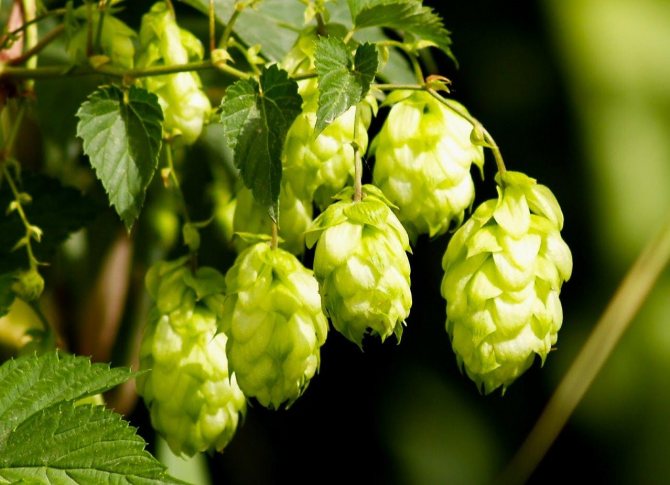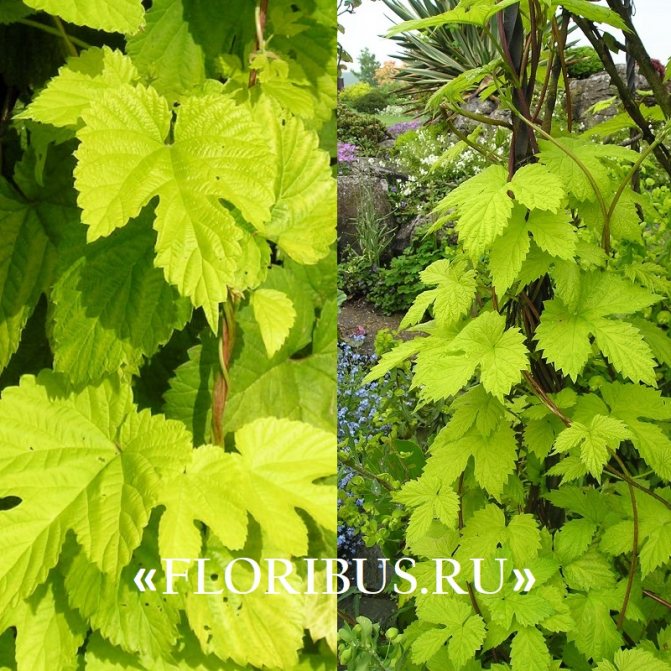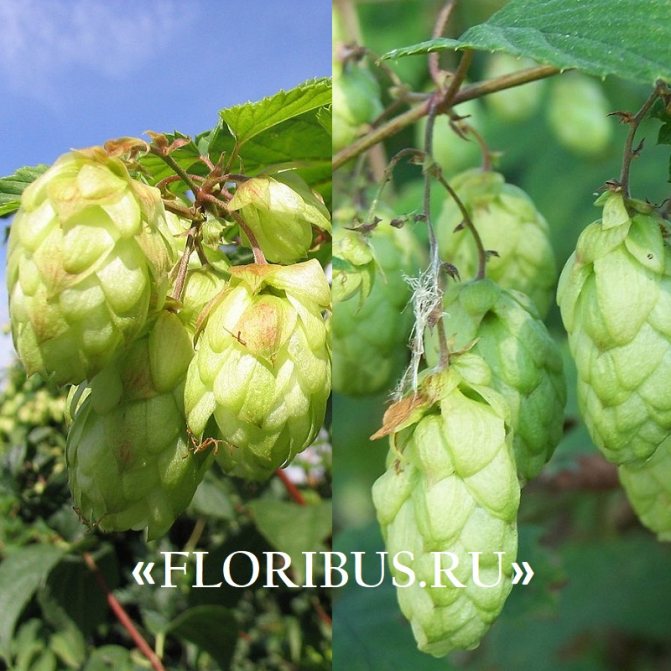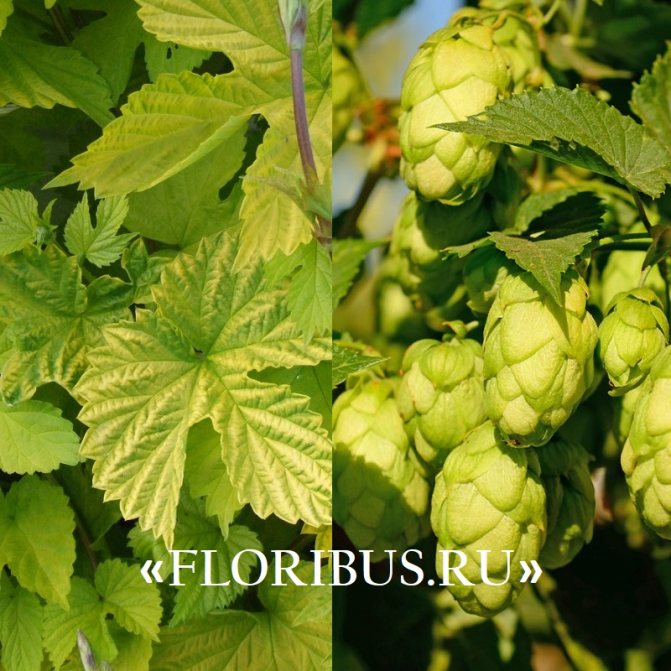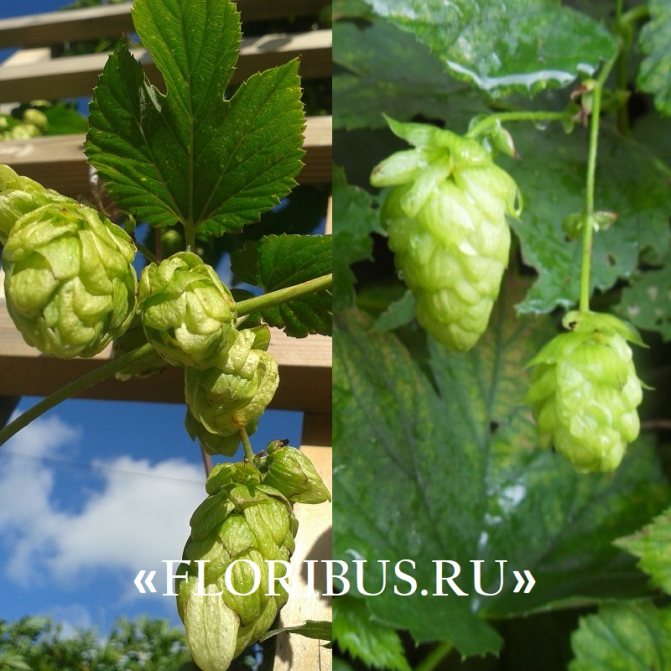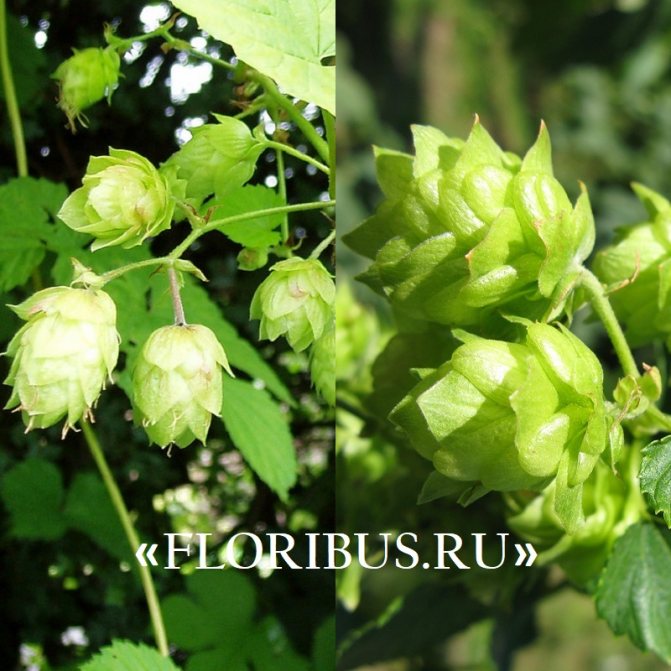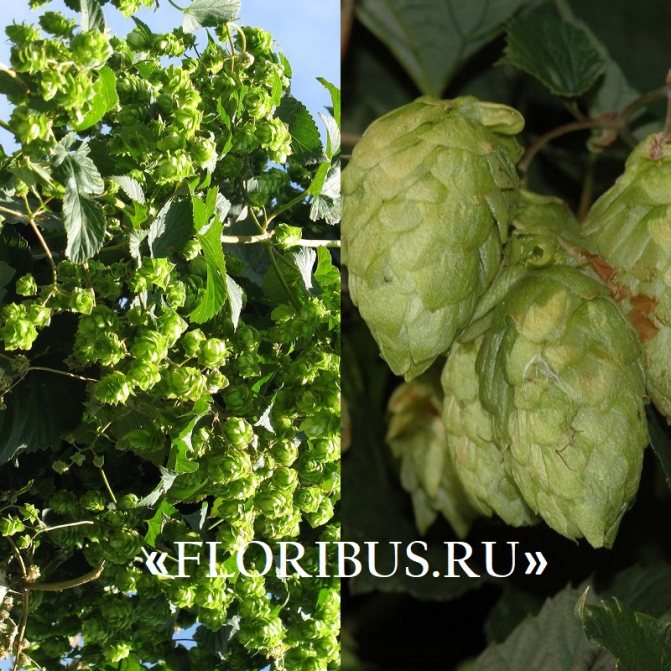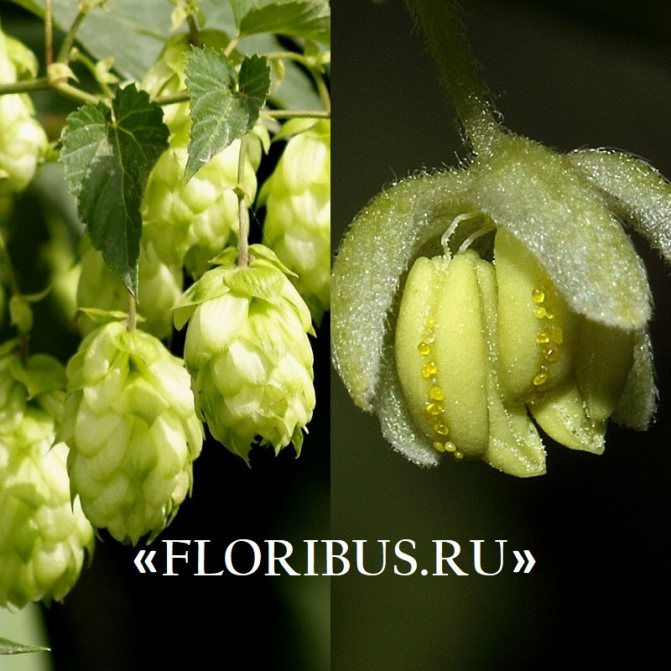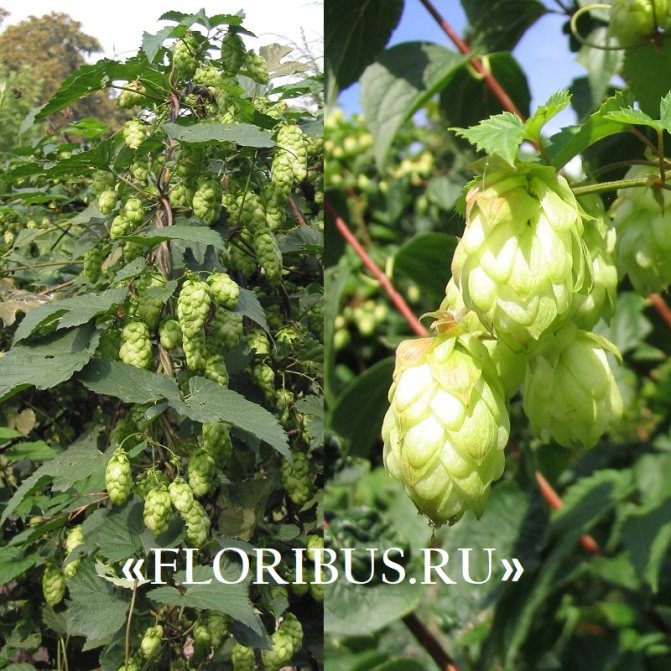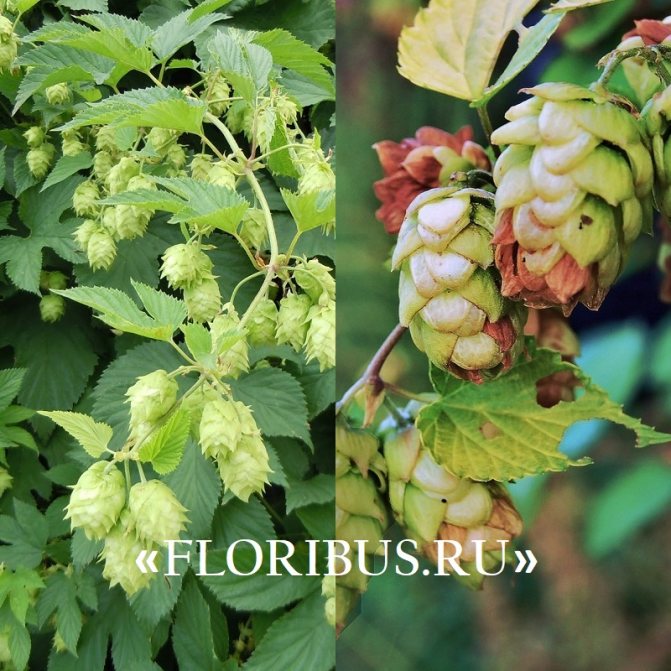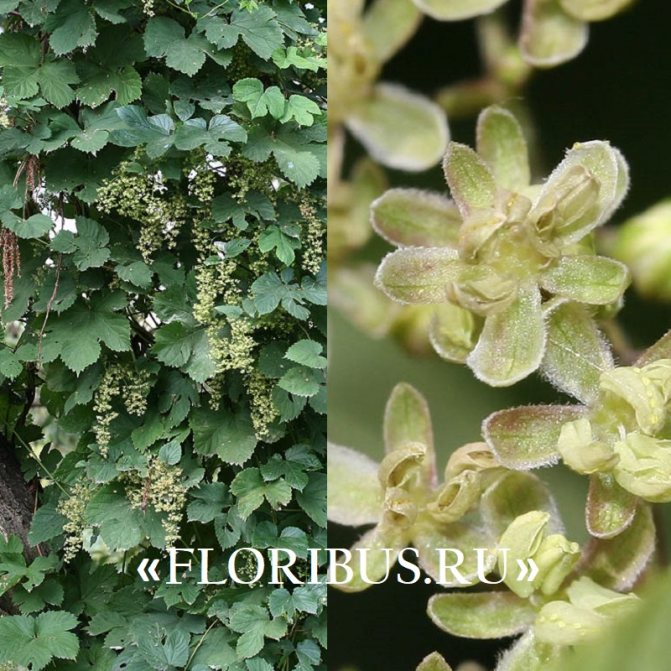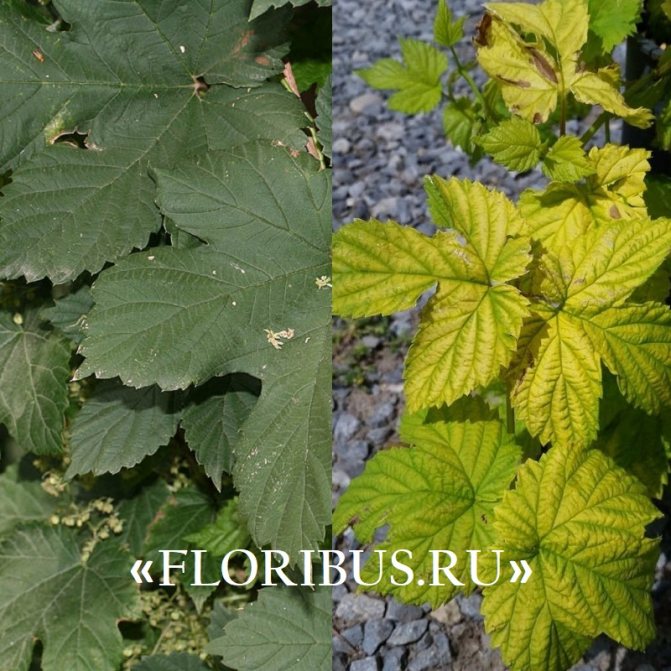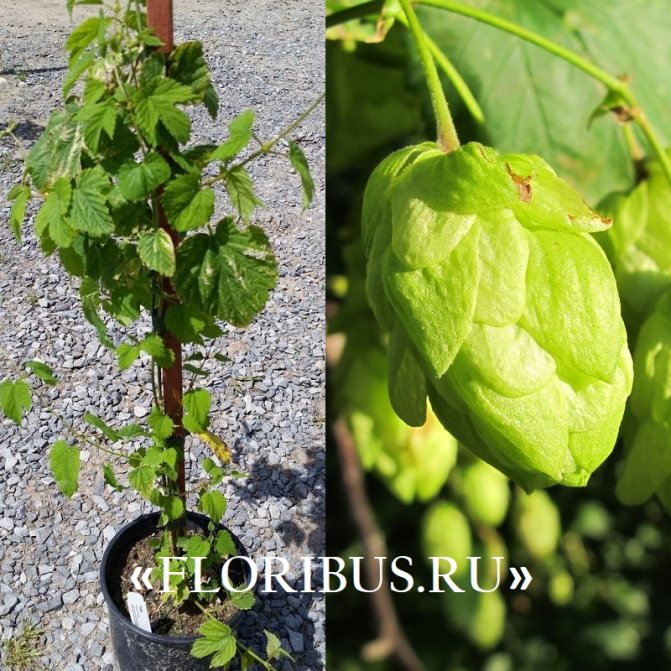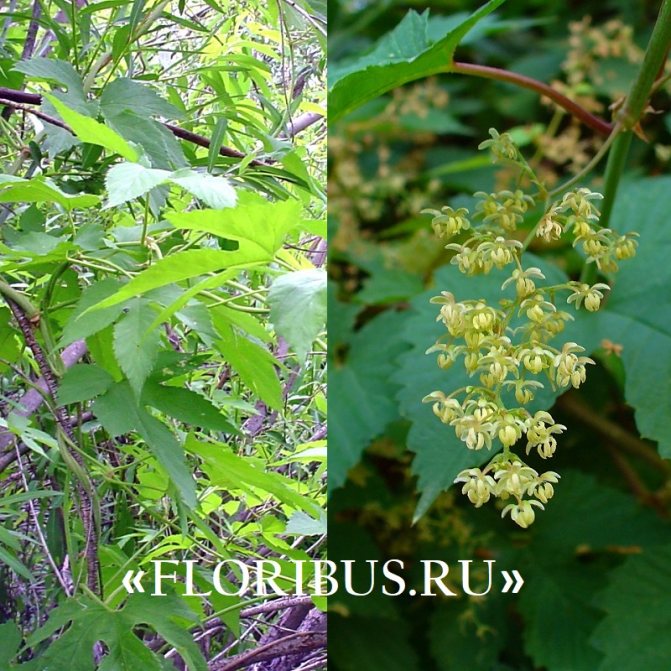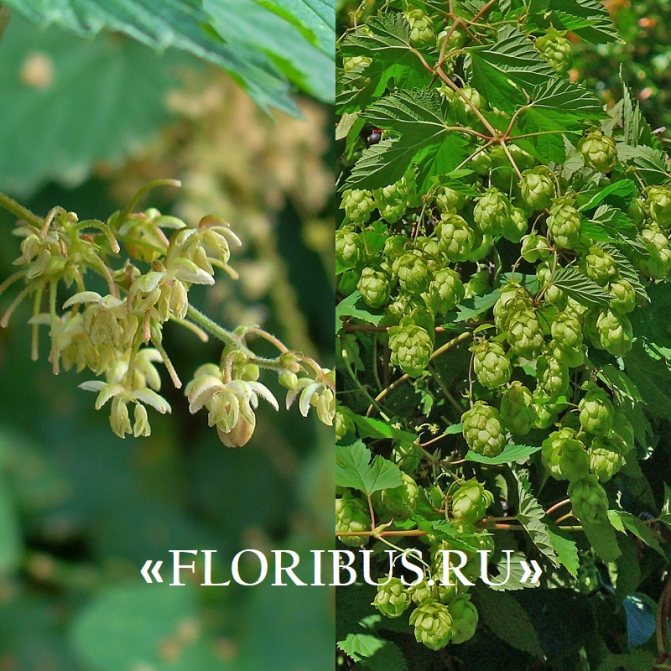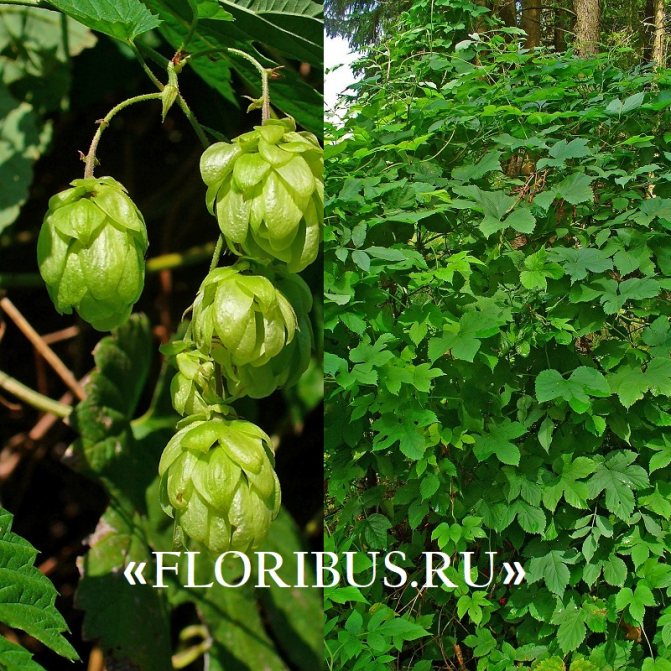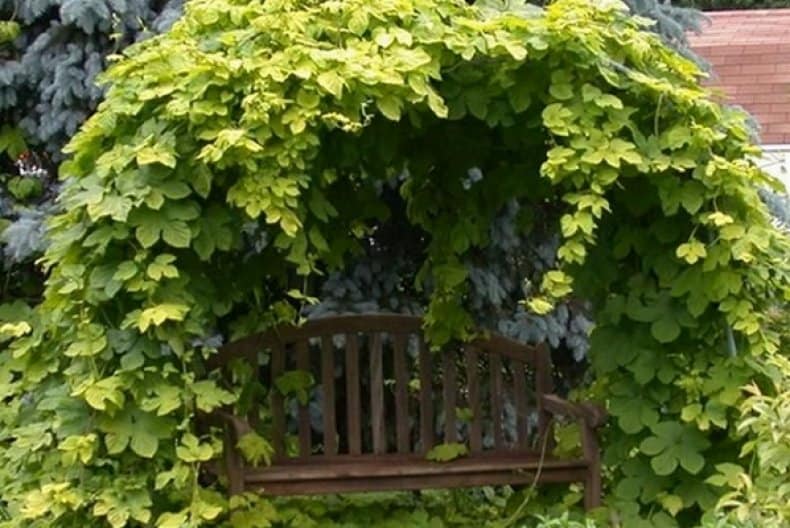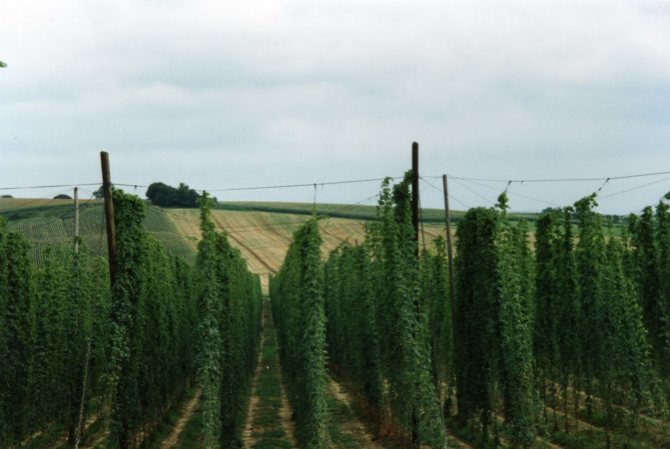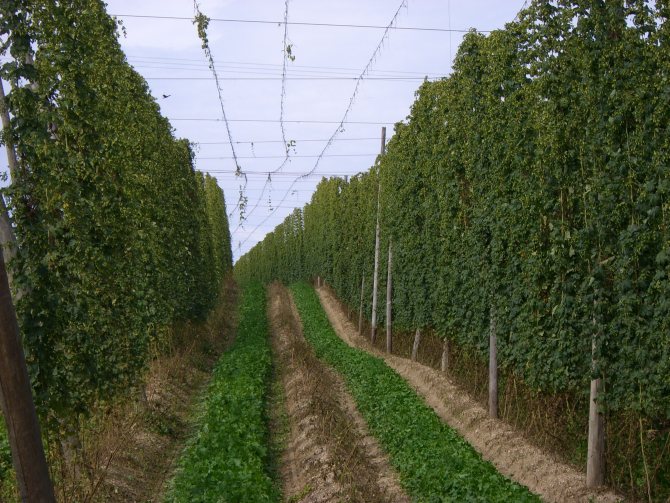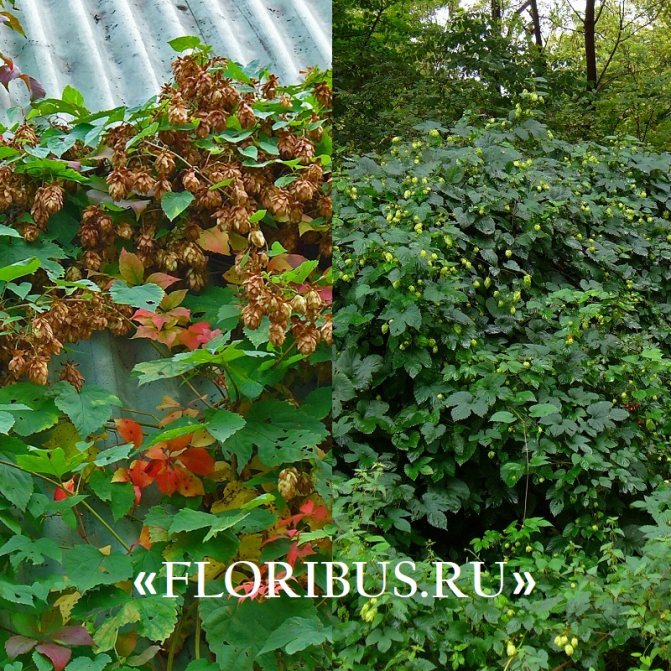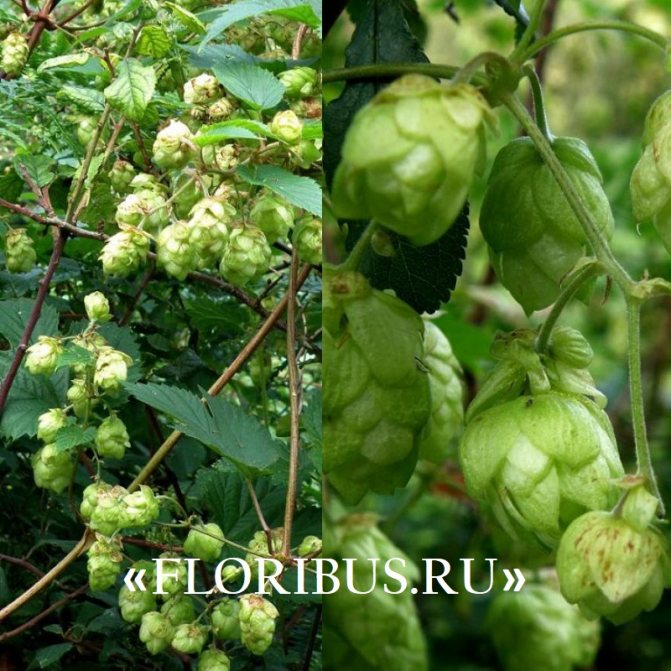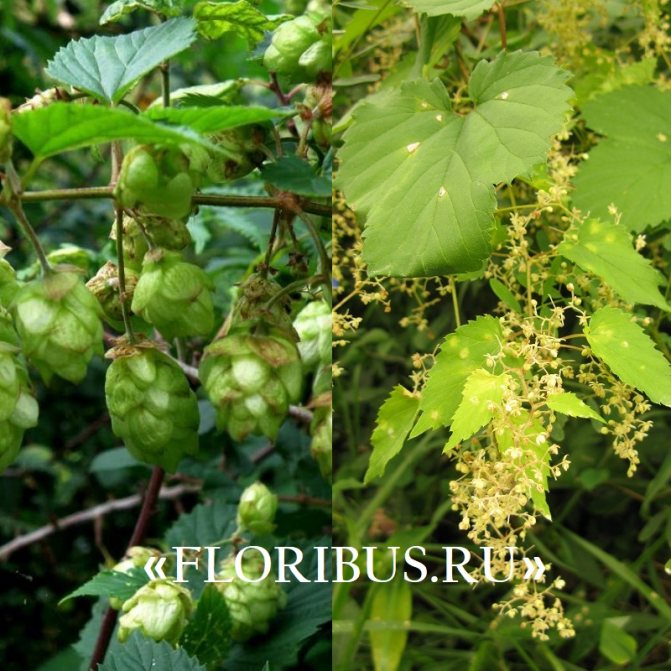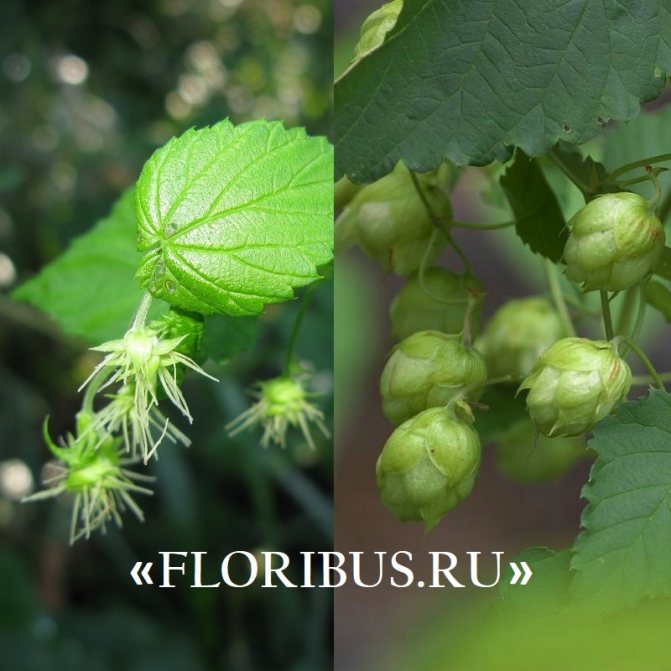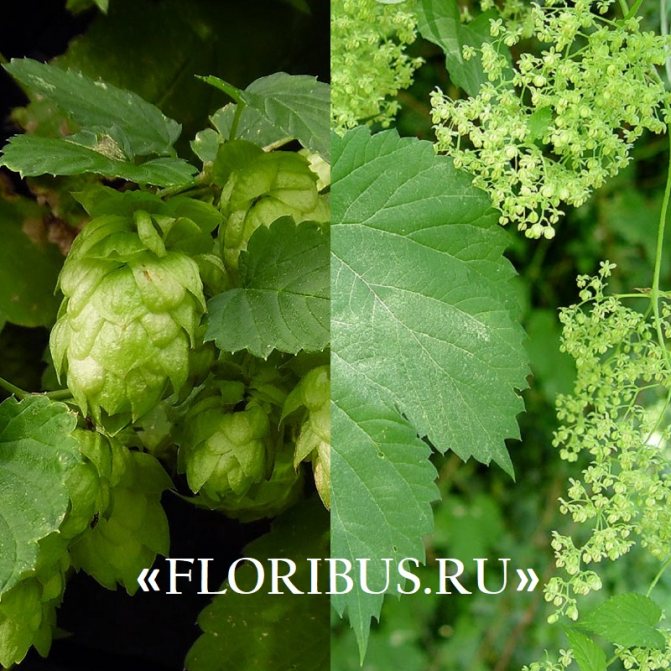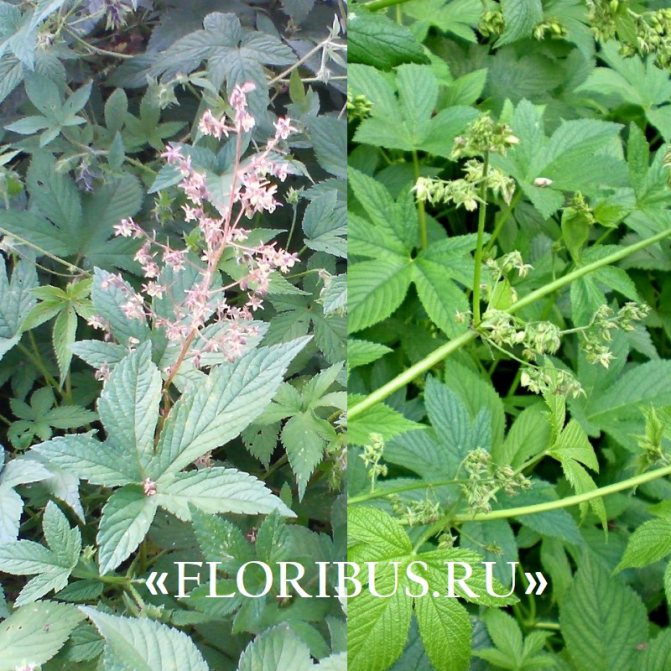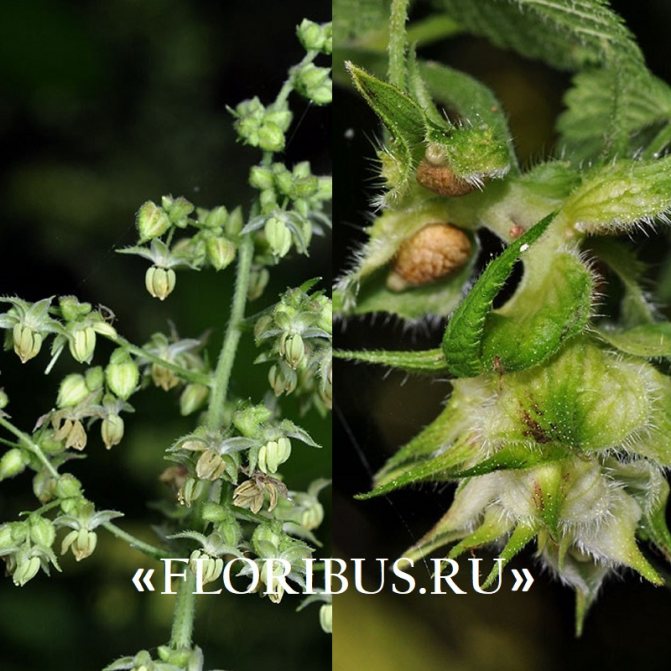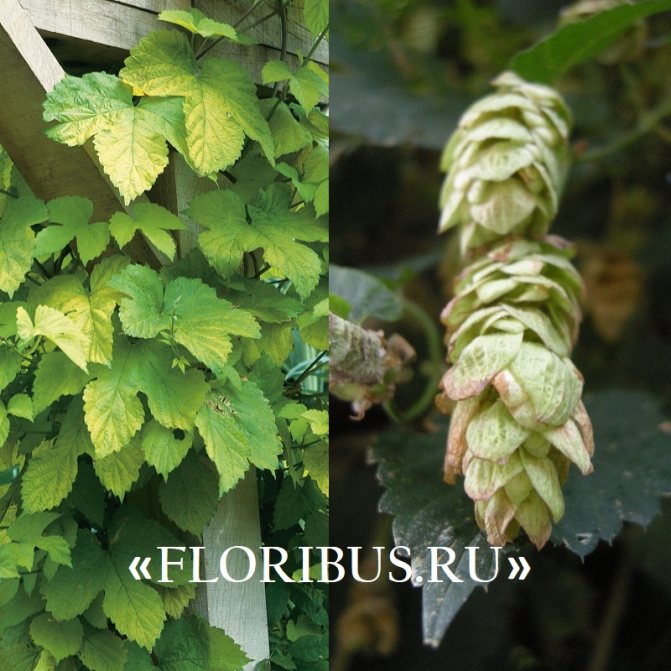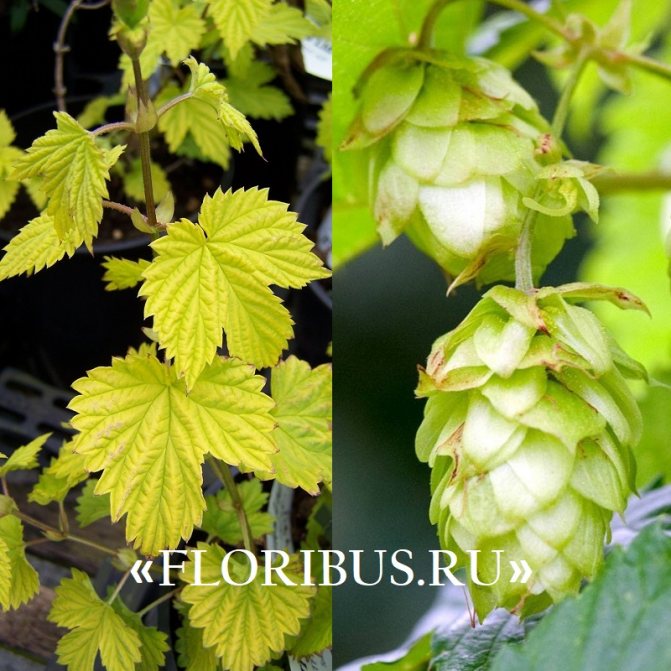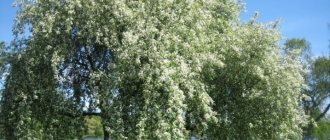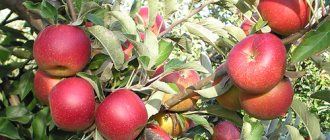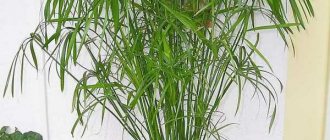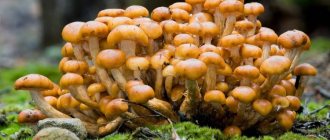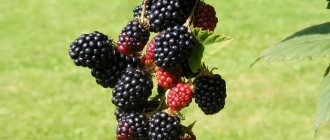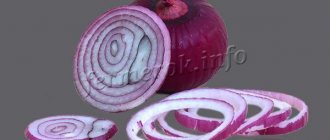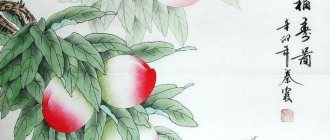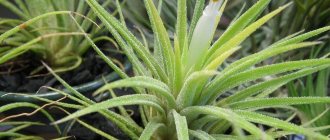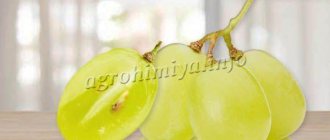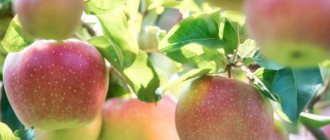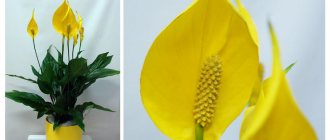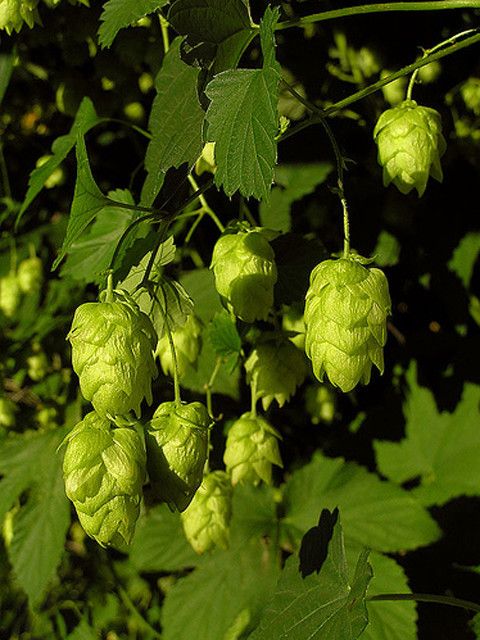
Common hops Is a perennial herbaceous climbing plant of the mulberry family.
Features: stem - tetrahedral, rough, elongated and curly, 4 ... 6 m long, clinging types to the trunks of trees and bushes; leaves - long-petiolate, oval or oval-ovate in outline with a heart-shaped base, three to five-lobed, with jagged edges, opposite, alternate in the upper part, smooth above, rough below; flowers - small, are divided into female and male, which are located on different plants: female - green with filmy scales-leaves, collected in ears, as they ripen, they grow into cones-cones of a yellowish-green color, male - drooping, in the form of hanging panicles on thin pedicels; hops bloom in July - August; fruits - small nuts, ripen from July to September.
Is growing everywhere: in the wild, it is found in damp forests, on the edges of bushes, in willow thickets, along the banks of rivers and ravines.
Hops are an ornamental plant; it winds, like a liana, along the walls of houses, verandas, gazebos, therefore it is widely cultivated in personal and summer cottages. Introduced into culture and grown on large areas as an essential component of raw materials for the brewing industry, it is used in bakery, as well as in the perfumery and cosmetic industry.
Description of culture and its photo
Let's start the description of the culture with the fact that common hop is a unisexual flowering plant. In the forests of Russia, male perennials are most often found. Regardless of the fact that the female plant can be located very far, it is pollinated with pollen, which is carried by the wind at a distance of up to 3 km. Long liana, reaches a height of 7-10 meters. Some perennials can be even longer with special care. The rhizome is long, creeping and very large. It does not go deep into the ground. According to the description, the dioecious crop grows due to the fact that its long stems twist clockwise and cling to the supports with sharp thorns in the form of hooks, which are located on the edges of hollow shoots.
Palm-shaped leaves are located oppositely on the stems. Plates are attached to the shoots with long herbaceous petioles. Flowers form in the leaf axils. Depending on the sex of the flower, specimens are divided into male and female. Most often, there are male representatives. Their flowers consist of 5 double-strand stamens and 5 perianth petals. The buds are collected in complex paniculate inflorescences. Male flowers are formed only on second-order stems.
Female flowers of common hop are collected in inflorescences, scutes, located in the axils of the leaves. They are equipped with bracts with small hairy glands, which secrete a substance with a high content of lupulin. The female flower consists of one pistil, covered at the base by a filmy perianth in the form of a bowl.
Flowering occurs from the first days of July to the end of August. After this process, the fruits ripen - brown nuts with an embryo, which are bent in a spiral.
It grows clockwise. His ground part is developing very quickly. In winter, all the greenery and shoots that are above the ground die.What remains is the rhizome (underground shoot), which is highly resistant to low temperatures. From the first days of warm spring days, the perennial develops very quickly. Its shoots in one day with favorable weather can grow up to 15-16 cm in length. The stems are attached to the supports with sharp hooks with which their ribs are equipped.
Follow-up care rules
Hops are difficult to grow. This process depends on many details. The plant can suffer from pest attacks or the development of diseases. Therefore, it is important to carry out sanitary pruning in a timely manner. To do this, remove the root leaves from the shoots. The procedure should be carried out after 3-4 months of rapid growth. After planting work, it is recommended to cover the bed with a mulch layer. It is best to use peat for this purpose.
Top dressing
In order to grow hops, the plant is recommended to provide a complete feeding. It is carried out in the standard way in spring and autumn. In early spring, mineral supplements are recommended. It is also permissible to use potassium-phosphorus fertilizers. In the fall, it is worth adding manure and compost.
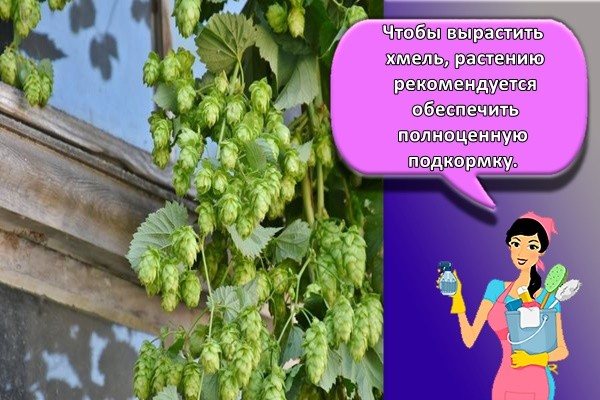

Watering mode
Liana is considered a moisture-loving plant. Therefore, it is recommended that she ensure sufficient soil moisture. It is worth making sure that there is no stagnation of moisture. In the summer, it is enough to water the culture once a day. After harvesting, the amount of soil moisture should be reduced.
Stealing
Complete hop care is impossible without timely shoot removal. When the sprouts reach 15-20 centimeters, they are cut off. Each bush should have 5 powerful branches. When the shoots grow up to 50 centimeters, they should be put on a support.
Usually there should be 3 stems per support. It is recommended to remove excess shoots as the culture develops.
It should be borne in mind that hops are capable of provoking oppression of neighboring plants. To avoid this, it is recommended to constantly monitor the development of culture. Pinching is of no small importance. It consists in shortening the side shoots. This procedure increases the yield of the buds.
Pest control
Hops often suffer from attacks from harmful insects. To cope with parasites, it is recommended to use effective insecticides in a timely manner. Most often, experts advise using solutions of Cuprozan or Polycarbacin.
If you do not want to use chemicals, you should use tobacco infusion. A mild soapy solution or wormwood decoction is also suitable.
Proper care of the planting is of no small importance. In the fall, it is recommended to remove dead stems and dig up the soil between plantings. When spraying, it should be borne in mind that most of the insects accumulate on the underside of the leaves. Therefore, you should definitely pay attention to this part of the plant.
See also
Rules for the care and cultivation of indoor lilies at home, the best varieties
Spider mite
This is a dangerous pest, which can be identified by the accumulation of cobwebs on the bushes. Soap solution or insecticidal preparations will help to cope with it.
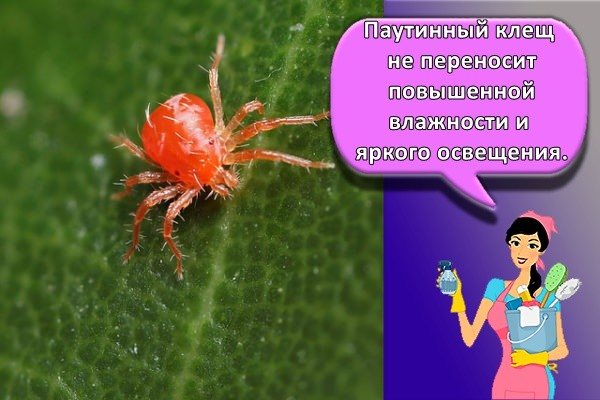

Wireworm
This pest is the larvae of the click beetle. It eats up the shoots of the plant and significantly impairs their development.
To eliminate parasites, it is worth using tobacco infusion.
Weevil
The elongated front of the head is considered a characteristic feature of the pests. The parasites feed on the leaves and roots of the culture. Insecticides will help to cope with them.
Aphid
These small pests accumulate on the seamy side of the leaves and lead to their damage. It is recommended to use a soapy solution to kill aphids.
How to care during a rest period
In the fall, after the leaves have wilted from a perennial bush, it is worth cutting off all dry shoots. After trimming them, it is recommended to apply fertilizers.Cover the rest of the bush with a layer of soil from above. Its thickness should be at least 30-40 centimeters.
The roots of the plant can easily endure the winter. With the arrival of spring, they begin to grow again. If the crop is annual, it is recommended that it be completely dug up and disposed of.
Support
The plant has quite powerful shoots. Therefore, it needs strong and high support. Some hop shoots are capable of reaching 10 meters. You can make a support yourself. An excellent option would be to locate the support on the south side of the house. To do this, lower the rope from the roof and fix it on the ground.


The use of hops and medicinal properties
As you know, ordinary hops have been used since time immemorial. Even in ancient Russia, cones were used to purify the blood, as well as a diuretic and choleretic agent for various diseases. At the moment, even more is known about the use and medicinal properties. The cones (female) contain the substance lupulin, which has many beneficial properties.
For example, lupulin helps with disorders of the central nervous system. Hop cones are used for insomnia, wet dreams, sleep problems, and severe sexual excitability. Some doctors suggest using raw materials for cardiovascular diseases.
The high content of nutrients allows the culture to be used for serious injuries and spasms, as a pain reliever. Broths based on cones are used to relieve inflammation. For ulcers, it is also recommended to try taking funds based on it, which help relieve severe pain attacks during an exacerbation of the disease.
Bump-based recipes are great for strengthening blood vessels and veins. Raw materials help to restore the body's metabolism. It improves the work of the systems responsible for water, fat and mineral metabolism.
Pimping for greater effect
There are three main strategic goals to focus on when mixing different hop varieties: strengthening, emphasizing, and complementing.
Strengthening means increasing the effect of the individual components of the hop bouquet. For example, Citra hops can be used to create tropical fruit notes. However, during the brewing process, the combination of Citra oils and / or other ingredients can lead to unexpected results and muffle the cherished tropical "fruitiness" in beer. In this case, increasing the overall Citra will make little difference, but the addition of other "tropical" hops (Equinox, Galaxy and even Polaris, which imparts a pronounced pineapple flavor) - one or more - is more likely to succeed.
Emphasizing refers to the use of contiguous flavor and aroma characteristics to embody or highlight a particular flavor and aroma. Let's say you want to get a mango flavor (let's continue the fruity-tropical theme, since we already turned to it). If you choose a hop variety that helps you achieve the hue you want and only use it, you may or may not get mango notes. Suppose you still managed to achieve your goal, but the matter does not end there. After all, you must also take into account the perception of those who will drink your beer, and ensure that they correctly capture and / or identify all the components of the bouquet! Help them cope with this sometimes daunting task: add hops to add tones of papaya, peach, pineapple or other tropical fruits. Ask your friends what they taste like rhubarb, and at least a few of them will say "berries." In fact, this is not the case, however, strawberries and cranberries are often added to rhubarb pie, which explains its “berry” flavor.Skillful mixing of hops can help you meet the expectations of those who drink your beer.
The addition is to create effective flavor and aroma contrasts. We tend to go beyond pale and chocolate malts to brew a stout. Additionally, we aim to achieve caramel tones and roasted grain notes that will add a more complete malt character. A similar situation is with hops: creating only one shade in a bouquet does not always allow to fully reveal the hop component of the final drink. So, fruity tones go well with notes of grass. Orange - with herbs. Pine - with woody-mint notes of the Northern Brewer variety. Complex, complementary flavors and aromas will give your beer a more original complex profile.
Where do these combinations come from? You can keep a record of successful recipes and blends that you happen to meet, as well as your own successful brewing experiments. I also brought up some successful combinations that have never let me down. Alternatively, you can use ready-to-use mixes such as Falconer’s Flight or Falconer’s Flight 7C’s. It should be borne in mind that not all hop combinations or blends "work" equally well for all brewers. Remember, trying is not torture.
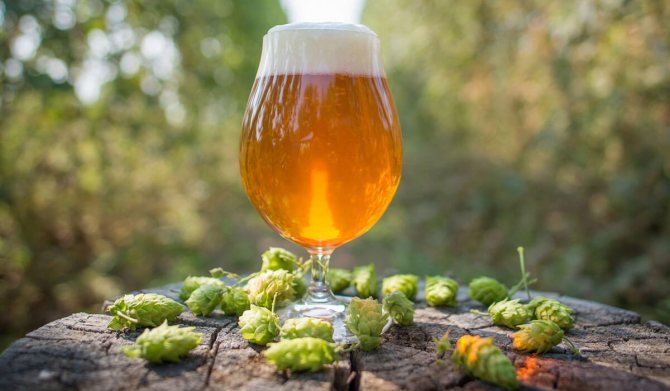

Photo:
Dioecious vine cones
Hop cones are also actively used in cosmetology. The beneficial substances contained in them are recommended in the treatment of rashes that occur together with itching or in case of allergic reactions. The prepared products have a beneficial effect on the epidermis, relieve irritation and alleviate the symptoms of acne.
Dioecious liana cones are very valuable as medicinal raw materials, so it is worth knowing a few rules on how to properly collect material from a plant. This is best done during the period when they begin to ripen - at the beginning of August. At this time, the glandular hairs secrete a lot of lupulin. Cones are dried in partial shade (in no case in the open sun) unfolded. It is impossible to dry hops in a suspended state, like other herbs, since lupulin can completely spill out, and the cone will lose its precious medicinal properties.
They are dried together with the flower-bearing legs, since at their base there is an accumulation of glands that emit useful substances. After the material has dried, it can be used for 3 years.
The main thing is not to overdo it
Overloading the recipe with different varieties of hops is like drawing with pencils of all colors of the rainbow: the output can be a very awkward "masterpiece".
This is a very multifaceted issue that we can discuss for a long time. For a comprehensive understanding of what we know about hops, what it is made of and how what it is made of works under certain conditions, I recommend reading Stan Hieronymus's book For the Love of Hops. . per.), as well as his excellent article "Oils and Flavors of Hops: An Uncharted Planet." These are great sources of valuable information to help you improve the quality of your beer.
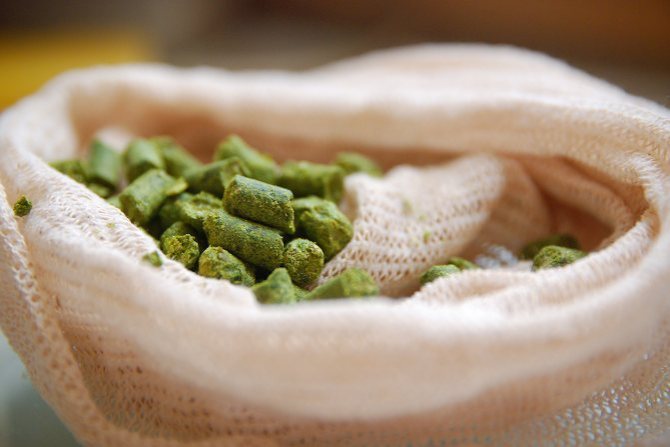

Photo: zolakoma
Breeding methods: division, cuttings and seeds
All methods are used to multiply hops. It is easy to get new vines by dividing the bush. In the spring, the mother specimen is not dug out, but part of the rhizome is separated from it along with the root processes. Landing is done immediately on a prepared place in a hole with a soil rich in humus. It is recommended to divide the bush only in the spring, when new shoots appear - this will increase the survival rate.
The second simple way is to divide the root and propagate the hops by cuttings of the rhizome. The plant is dug up in the spring. Thoroughly clean the root of an earthen lump, if any, and inspect its surface for integrity. Healthy rhizomes are cut into pieces, up to 12-15 cm long.Each root cut should have at least 2-4 pairs of healthy growth buds. In this case, the diameter of the section of the root shoot should be at least 2 cm. Root cuttings are planted in a garden bed or in a container filled with wet sand or moss and left to grow. When the first signs appear that have taken root, you can transplant to a permanent place.
Hops are grown with seeds if you need to plant a large area, for example, this is necessary in the production and processing of useful raw materials. For seedlings of plants, not deep containers are suitable - bowls. Sow hop seeds a couple of months before planting. The planting material quickly gives the first shoots, therefore, in some cases, it can be sown directly into open ground.
If seeds were sown for seedlings, then very young shoots can be transplanted into open ground - as soon as the first shoots appear. In the second year, the perennial will begin to develop rapidly. In the first season, the seedlings take root and adapt to constant conditions and grow very slowly. Due to the fact that during seed reproduction, a large number of male plants may appear, they are planted in large groups, and the method is used extremely rarely.
After vegetative propagation, cones can be harvested in the first year. But, their number will be about half that of adult hops.
What place in the garden is suitable for a plant
The best hop spot is in partial shade. In the sun, the plant is more susceptible to disease and is more likely to be damaged by insects. The soil for liana is preferable to loamy. Hops grow worst of all on sandy soils.
Before planting, it is imperative to install supports, to which the vine will cling in the future. Moreover, it should be borne in mind that the hop rises very quickly vertically, and if it is directed horizontally, the growth slows down greatly.
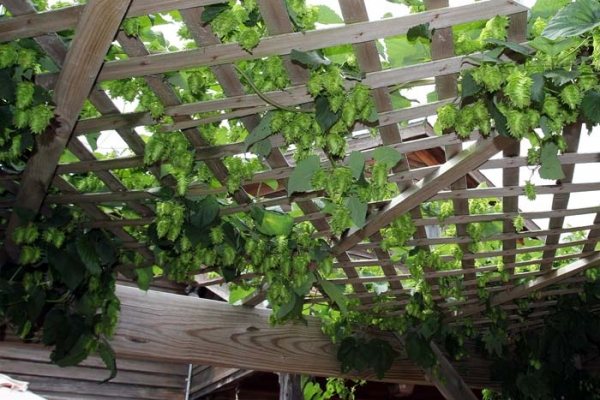

The best place for hops is partial shade
Having the peculiarity of tightly joining together, the hop leaves create a thick shadow. This should also be taken into account when planting it in order to decorate a veranda or porch.
Advice. At the end of summer, on the lower part of the vine, the leaves turn yellow and crumble. To “hide” this, it is better to plant short plants with beautiful leaves nearby.


